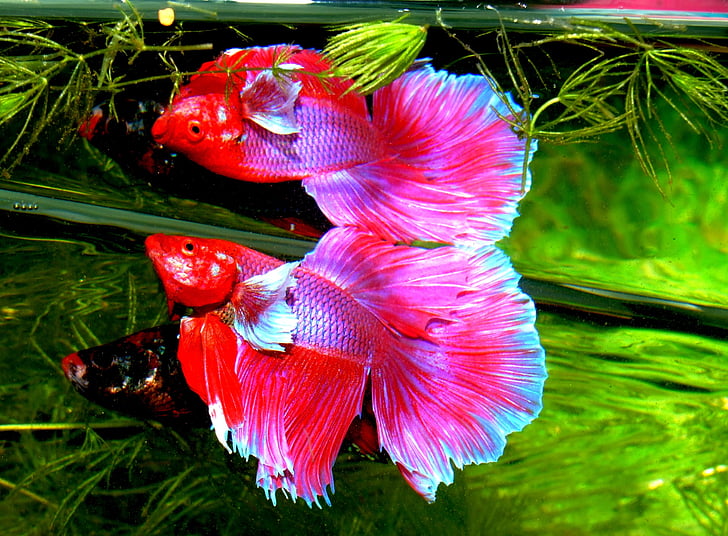Table of Contents
If you’re considering getting female betta fish, you may be wondering if they can live together. The short answer is yes, female bettas can live together under certain conditions. However, it’s important to understand the risks and challenges that come with keeping multiple bettas in the same tank.
Female bettas are less aggressive than males and can often coexist peacefully in the same tank. However, they still have a natural instinct to establish a hierarchy and may become territorial. It’s essential to provide enough space and hiding spots for each fish to establish their territory and avoid conflicts. Additionally, introducing new fish to an established group can be challenging, and it’s crucial to monitor their behavior closely to prevent aggression.
Understanding Betta Fish
Betta fish, commonly referred to as Siamese fighting fish, are a well-liked species of freshwater pet fish, renowned for their striking colors and lengthy fins. They are social creatures and can be accommodated in community tanks with other fish, but it is crucial to comprehend their conduct, personality, and temperament before introducing them to other fish.
Male betta fish are recognized for their aggressiveness and territorial behavior, hence why they are frequently kept in solitary tanks. Female betta fish, on the other hand, can be kept together in groups of two or more, as long as there is enough space and hiding spots for each fish.
Betta fish have unique personalities and can display different levels of aggression and territorial behavior. Some female bettas may be more dominant than others and may need more space or hiding spots to feel comfortable.
It is important to note that betta fish can also display aggression towards their own reflection, which is why it is recommended to avoid placing their tank in front of a mirror or other reflective surfaces.
Betta fish can live up to 3 years on average, but their lifespan can vary depending on their care and environment. As they age, their vibrant colors may fade and their finnage may shorten. Male bettas may also develop a “betta beard” as they age, which is a growth under their chin that resembles a beard.
Female Betta Fish Behavior
Female betta fish are known for their aggressive and territorial behavior. While they are generally less aggressive than male bettas, they can still display aggressive behavior towards other female bettas.
In the wild, female bettas live in groups and establish a hierarchy or pecking order. This hierarchy helps to maintain social order and reduce aggression between the fish. However, in captivity, female bettas may not have enough space to establish a hierarchy, leading to increased aggression.
Signs of aggression in female bettas include flaring their fins, chasing other fish, and biting. If you notice any signs of aggression, it is important to separate the fish to prevent injury.
To reduce aggression between female bettas, it is important to provide them with enough space and hiding spots. A crowded tank can lead to increased aggression, while hiding spots can help to reduce stress and aggression.
Housing Conditions for Betta Fish
Providing sufficient space for female betta fish to coexist comfortably is imperative. The size of the tank or aquarium is a crucial factor to consider.
For two female betta fish, a minimum tank size of 10 gallons is recommended. However, a 5-gallon tank can work as well if you are diligent about monitoring the water conditions and performing regular water changes. A smaller tank, such as a 2-gallon tank, is not suitable for two female betta fish as it does not provide enough space for them to establish their territories and swim freely.
In addition to the tank size, the environment in which the fish are housed is also important. Female bettas can be territorial, so it’s important to provide plenty of hiding places and decorations to break up the line of sight within the tank. This will help to reduce stress and aggression between the fish.
Maintaining proper water conditions is also crucial for the health and well-being of your female betta fish. Regular water changes, along with a good filtration system, will help to keep the water clean and free from harmful levels of ammonia and other toxins.
Importance of Space and Territory
When it comes to keeping female betta fish together, providing enough space and territory is crucial. Betta fish are known for their aggressive behavior, and without enough space, they may become territorial and exhibit aggressive behavior towards each other.
In the wild, female betta fish live in large groups, and they establish a hierarchy based on their size and aggression. In an aquarium setting, it is essential to provide enough space and hiding places to mimic their natural environment.
The size of the aquarium is also important. A minimum of 10 gallons is recommended for two female betta fish. This provides enough swimming space and territory for each fish to establish their own space. A larger aquarium is always better, as it allows for more hiding spots and swimming space.
Providing hiding places is essential for female betta fish to establish their own territories. Hiding places can be in the form of plants, rocks, or decorations. These hiding spots should be spread out throughout the aquarium, allowing each fish to have their own space.,
The Concept of Betta Sorority
If you’re considering keeping two female betta fish together, you may have heard of the concept of a “betta sorority.” This refers to a group of female bettas living together in the same tank. The idea is that the females will establish a hierarchy and live peacefully together.
However, it’s important to note that not all female bettas will get along. Some may be more aggressive than others, and there’s always a risk of fighting and injury. It’s also important to have a large enough tank with plenty of hiding places and plants to help reduce aggression and provide a sense of security for each fish.
If you’re considering a betta sorority, it’s recommended to start with at least four female bettas. This helps spread out aggression and reduces the chance of one fish being singled out. It’s also important to have a backup plan in case the sorority doesn’t work out, such as having separate tanks ready.
It’s worth noting that adding a male betta to a sorority is not recommended. The male may become aggressive towards the females, and the females may become aggressive towards him. It’s best to keep males and females separate unless you’re specifically breeding them.
Interaction with Other Fish
When it comes to keeping female betta fish together with other fish, it is important to consider their compatibility and behavior. Female bettas are generally less aggressive than males, but they can still exhibit territorial behavior and aggression towards other fish.
In a community tank, it is best to keep female bettas with peaceful fish that are similar in size and temperament. Some good tankmates for female bettas include catfish, cory catfish, and guppies. However, it is important to note that even peaceful fish may become targets of aggression if they are perceived as a threat or invade the betta’s territory.
It is not recommended to keep female bettas with goldfish, gouramis, or cichlids as these fish can be aggressive and may harm the bettas. Additionally, it is important to avoid keeping male and female bettas together as they are likely to fight and can cause injury or even death.
When introducing new fish to the tank, it is important to acclimate them slowly and carefully to reduce stress and aggression. It is also important to provide plenty of hiding places and visual barriers in the tank to reduce aggression and territorial behavior.
Health Considerations
When considering keeping two female betta fish together, it’s important to take their health into consideration. While bettas are generally hardy fish, they can still be susceptible to various health issues.
One common issue is stress, which can be caused by a variety of factors such as poor water quality, overfeeding, or aggression from tank mates. Stress can weaken a betta’s immune system, making them more vulnerable to diseases and infections.
To prevent stress, make sure to keep the tank clean and well-maintained. Avoid overfeeding and provide plenty of hiding spots for your bettas to retreat to if needed.
Another important consideration is quarantine. Before introducing any new fish to your tank, it’s crucial to quarantine them for a period of time to ensure they are healthy and free of any diseases or parasites. This can help prevent the spread of illness to your other fish.
Proper Tank Setup
When it comes to keeping female betta fish together, a proper tank setup is crucial. Here are some important factors to keep in mind:
Tank Size
A tank size of at least 10 gallons is recommended for keeping two female betta fish together. This provides enough space for each fish to establish their own territory and reduces the likelihood of aggression.
Tank Decoration
A well-planted tank with plenty of hiding spots can help reduce stress and aggression between female bettas. Live plants such as java fern, anubias, and moss balls are great options. You can also add tank decorations such as caves, driftwood, and rocks to provide additional hiding spots.
Suitable Tank Mates
It’s important to only keep female bettas together in a tank. Male bettas and other aggressive fish should be avoided as they can lead to fights and injuries.
Water Parameters
Maintaining proper water parameters is important for the health of your fish. Female bettas prefer slightly acidic water with a pH between 6.5 and 7.5. The water temperature should be kept between 76-82°F.
Feeding
Feeding your female bettas a balanced diet is important for their health and well-being. A diet of high-quality pellets and occasional live or frozen foods is recommended.
Betta Fish Breeding
Breeding betta fish can be a rewarding experience, but it requires careful planning and preparation. In general, it is not recommended to breed bettas unless you have experience and are knowledgeable about the process.
Male bettas are the ones typically used for breeding purposes, as they are the ones that build bubble nests and have an ovipositor to fertilize the eggs. If you are considering breeding bettas, it is important to have a separate breeding tank for the pair and to ensure that the water conditions are optimal.
When breeding bettas, it is important to monitor the pair closely and ensure that they are compatible. If the pair is not compatible, it is possible that the male may become aggressive towards the female, which can result in injury or death.
Betta Fish in Their Natural Habitat
In their natural habitat, Betta fish, also known as Siamese fighting fish, are found in the shallow waters of rice paddies, swamps, and slow-moving streams in Southeast Asia. These waters are often murky and filled with vegetation, which provides the Betta fish with hiding places and a steady supply of food.
Betta fish inhabit a warm and humid environment, with temperatures fluctuating between 75°F to 86°F. The water is somewhat acidic, with a pH level of approximately 6.5 to 7.5. Since the water is low in oxygen, Betta fish have adapted to breathe air from the surface.
In the wild, Betta fish are solitary creatures and are known for their aggressive behavior towards other fish, especially males of their own species. They are territorial and will defend their space fiercely. However, they may coexist with other fish species as long as they are not seen as a threat.
It is important to replicate their natural habitat as much as possible when keeping Betta fish as pets. This means providing them with a tank that is at least 5 gallons in size, with plenty of hiding places and live plants. The water should be kept warm, and the pH level should be monitored regularly.
Common Misconceptions
When it comes to keeping female betta fish together, there are several common misconceptions that need to be addressed. Here are a few things you might have heard:
- “Female bettas can’t be kept together at all.” While it’s true that male bettas are notoriously aggressive and territorial, female bettas can actually live together peacefully in the right conditions. However, it’s important to note that not all female bettas will get along, and some may still be aggressive towards each other.
- “You can keep female bettas in a fish bowl.” Fish bowls are not suitable for any type of fish, including bettas. They are too small and don’t provide enough space or oxygen for the fish to thrive. Female bettas need at least a 5-gallon tank with a filter and heater to live comfortably.
- “Female bettas are small, so they don’t need much space.” While female bettas are smaller than males, they still need plenty of swimming room and hiding places in their tank. A cramped tank can lead to stress and aggression, even among female bettas that would normally get along.
Conclusion
In conclusion, while it is possible for female betta fish to live together, it is important to remember that these fish are territorial. Therefore, there is a risk that they may become aggressive towards each other.
If you do decide to keep multiple female bettas in the same tank, there are a few things you can do to increase the chances of success. Firstly, make sure you have a large enough tank with plenty of hiding places and plants. This will give each fish their own space and reduce the risk of conflict.
It is also important to introduce all the fish at the same time. This will prevent any one fish from establishing dominance over the others. Additionally, make sure to monitor the fish closely for any signs of aggression or stress. If you notice any issues, it may be necessary to separate the fish.
Overall, it is possible to keep multiple female bettas together, but it requires careful planning and monitoring. If you are unsure, it may be best to keep each fish in its own tank to ensure their safety and well-being.







